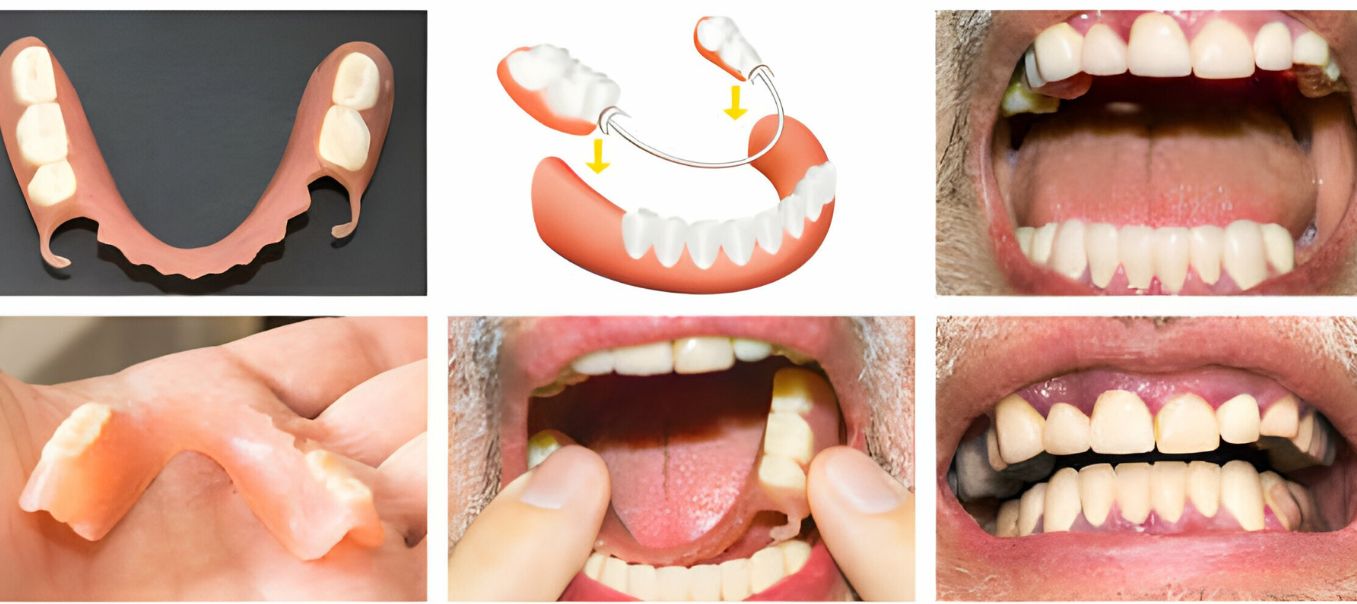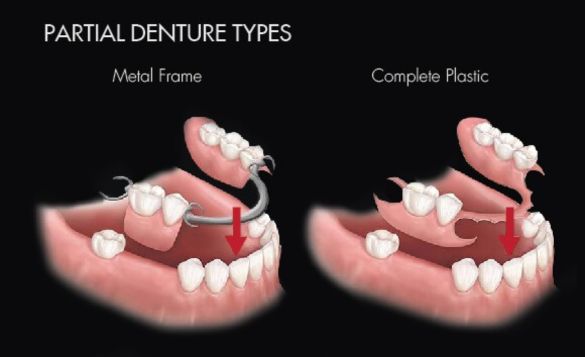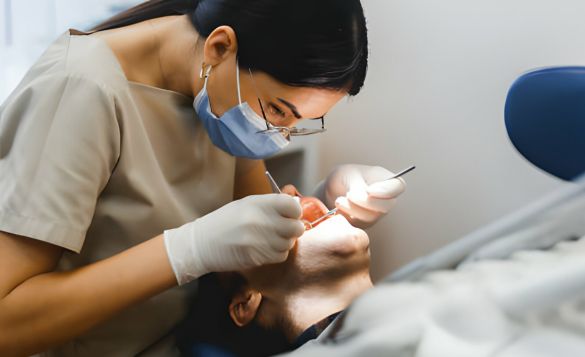
Archives
Categories


Missing teeth can greatly impact not only your smile but also your confidence and overall well-being. Thankfully, modern dental advancements offer a variety of solutions to restore your smile and functionality. One such option is partial dentures, a removable dental appliance designed to replace one or more missing teeth.
Before diving into the details of how partial dentures work, it’s important to understand the challenges posed by missing teeth. Beyond aesthetics, gaps from missing teeth can lead to difficulties in chewing, and speaking, and even cause neighboring teeth to shift. Partial dentures provide an affordable and convenient solution by filling these spaces, improving function, and enhancing your smile.
In this article, we will explore the benefits of partial dentures, the different types available, and what to expect before and after getting them fitted. Whether you’re considering getting partial dentures or simply want to learn more about this tooth replacement option, our comprehensive guide will provide you with the information you need to make an informed decision.
Partial dentures are dental appliances designed to replace one or more missing teeth. Unlike full dentures, which replace all the teeth in the upper or lower jaw, partial dentures can be used when some natural teeth remain. They consist of replacement teeth attached to a gum-colored base, which is typically made of acrylic or metal. The base is custom-made to fit comfortably in your mouth and blend seamlessly with your existing teeth. Partial dentures offer several benefits compared to other tooth replacement options. Let’s explore them in the next section.

Improved function: Partial dentures restore your ability to chew and speak properly, making it easier to enjoy your favorite foods and communicate clearly. They distribute the forces of biting and chewing more evenly, reducing the strain on your remaining natural teeth.
Enhanced aesthetics: Partial dentures not only fill in the gaps left by missing teeth but also improve the appearance of your smile. The replacement teeth are designed to match the color, shape, and size of your natural teeth, resulting in a seamless and natural-looking smile.
Boosted self-confidence: Missing teeth can have a significant impact on your self-esteem. Partial dentures help restore your smile, allowing you to feel more confident in social and professional settings. You no longer have to worry about hiding your teeth or feeling self-conscious when interacting with others.
Prevents further oral health issues: Gaps from missing teeth can cause neighboring teeth to shift, leading to misalignment and bite problems. Partial dentures help maintain the alignment of your remaining teeth, preventing further oral health issues such as tooth decay and gum disease.
Before getting partial dentures, you will need to undergo a consultation and examination with your dentist. This step is crucial to ensure that partial dentures are the right solution for your specific needs. During the consultation, your dentist will evaluate the condition of your teeth and gums, take impressions of your mouth, and discuss the treatment plan with you.
Once it is determined that partial dentures are the appropriate option, the next step is preparing for the fitting. This involves several important considerations, which we will explore in the next section.
During the consultation and examination, your dentist will thoroughly evaluate the health of your remaining teeth, gums, and jawbone. They will also take X-rays and impressions of your mouth to create a model of your teeth. This model will be used to design and create your custom-made partial dentures.
Your dentist will discuss the treatment plan with you, explaining the different types of partial dentures available and helping you choose the best option based on your specific needs and preferences. They will also provide detailed instructions on how to prepare for the fitting of partial dentures, which may include steps such as extracting any remaining unhealthy teeth and ensuring that your gums are in good condition.

Before getting your partial dentures fitted, your dentist may recommend some preparatory steps to ensure optimal results. These steps may include:
Tooth extractions: If you have any remaining unhealthy teeth, your dentist may recommend extracting them before the fitting of partial dentures. This is necessary to create a stable foundation for the dentures and prevent further oral health issues.
Gum health: It is essential to have healthy gums before getting partial dentures. Your dentist may recommend treating any gum disease or infections and ensuring that your gum tissues are in good condition. This will help promote a comfortable fit and prevent discomfort or irritation.
Temporary dentures: In some cases, your dentist may provide you with temporary dentures to wear while your custom partial dentures are being fabricated. These temporary dentures will help you adjust to wearing and speaking with dentures and provide a temporary solution for missing teeth.
After getting your partial dentures fitted, it’s normal to experience an adjustment period. Your mouth and gums may need time to adapt to the presence of the dentures. It’s common to experience some initial discomfort, soreness, or difficulty speaking and chewing. However, these issues usually subside within a few weeks as your mouth adjusts to the dentures.
During the adjustment period, it’s important to follow your dentist’s care instructions to ensure the longevity and proper functioning of your partial dentures. Here are some essential care tips:
Oral hygiene: Maintain good oral hygiene by brushing your remaining natural teeth, gums, and tongue twice a day using a soft-bristle toothbrush. Clean your partial dentures daily using a denture brush and mild soap or denture cleaner. This will help prevent plaque buildup, bad breath, and oral infections.
Soaking: Remove your partial dentures before going to bed and soak them in a denture cleaning solution or water overnight. This helps keep your dentures clean and prevents them from drying out or warping.

Sore spots: It’s normal to experience sore spots or irritation in your mouth during the initial adjustment period. If sore spots persist or develop later on, contact your dentist for an evaluation. They can make adjustments to your dentures to alleviate discomfort and prevent further irritation.
Slippage or looseness: If your partial dentures feel loose or slip out of place while speaking or eating, it may indicate a need for adjustment. Contact your dentist to address the issue and ensure a snug fit. Avoid using adhesives without consulting your dentist, as they may mask underlying problems.
Odor or staining: Improper oral hygiene can lead to odor or staining of your partial dentures. Clean your dentures regularly as instructed by your dentist to eliminate bacteria and prevent discoloration. If persistent odor or staining occurs, consult your dentist for further guidance.
While partial dentures are an effective tooth replacement option, there are alternative solutions available. Some of these alternatives include dental bridges, dental implants, and implant-supported dentures. Each option has its own advantages and considerations, and it’s essential to consult with your dentist to determine the best choice for your specific needs.
Partial dentures offer a convenient and affordable solution for replacing missing teeth, restoring function, and enhancing your smile. They provide numerous benefits, including improved chewing ability, enhanced aesthetics, and boosted self-confidence. By following proper care instructions and seeking regular dental check-ups, you can ensure the longevity and optimal functioning of your partial dentures.
If you’re considering partial dentures, consult with your dentist to determine if they are the right option for you. Together, you can create a treatment plan that meets your unique needs and helps you achieve a beautiful and functional smile.
Some disadvantages of partial dentures may include initial discomfort, potential difficulty in speaking or eating, the need for periodic adjustments, and a possible risk of damaging adjacent teeth if not properly cared for.
Yes, you can eat with partial dentures. However, it may take some time to adjust to eating with them, especially with certain foods. Initially, it’s recommended to start with softer foods and gradually reintroduce harder or stickier foods as you become accustomed to wearing them.
The lifespan of partial dentures varies depending on factors such as oral hygiene, wear and tear, and changes in the mouth’s structure. On average, they can last around 5 to 7 years with proper care and regular maintenance.
Adjusting to partial dentures may take some time, typically ranging from a few days to a few weeks. Initially, you may experience discomfort, difficulty speaking, and challenges with eating certain foods. However, with patience and practice, most individuals adapt to their partial dentures and find them comfortable to wear. Regular use and proper oral hygiene also contribute to a smoother transition.
Our website uses cookies to improve your experience. Learn more about: Cookie Policy
Leave a Reply